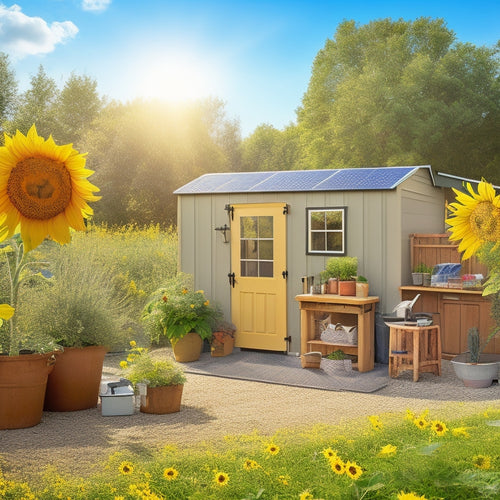
Solar Panel Setup for Home
Share
You're taking the first step towards a cleaner, more sustainable energy future by considering a solar panel setup for your home. To maximize your benefits, you'll want to assess your roof's shading, guaranteeing ideal sunlight exposure for your panels. High-efficiency solar panels with conversion rates above 20% will give you the most bang for your buck. By implementing maximum power point tracking, you'll confirm your system operates at peak conditions. With proper installation and maintenance, you can start saving money fast, reducing your energy expenses by up to 50%. Now, get ready to utilize the full potential of solar energy.
The Essentials
- Solar panels can significantly reduce your carbon footprint and energy expenses with a potential 50% reduction in energy bills.
- Optimal solar panel setup requires a south-facing roof with minimal shading, ensuring maximum energy production and efficiency.
- High-efficiency solar panels with conversion rates above 20% can increase energy production, and energy storage options can store excess energy.
- Regular maintenance, including cleaning and performance monitoring, is crucial to sustain output efficiency and maximize energy production.
- Transitioning to solar energy can increase your home value, appeal, and provide long-term financial relief through federal tax credits and local rebates.
Zero Carbon Footprint
You're taking a considerable step towards reducing your energy dependence on the grid by installing a solar panel setup at home.
By utilizing renewable energy, you'll greatly lower your reliance on fossil fuels, contributing to a cleaner environment.
With the ability to store excess energy, you can also break free from reliance on the grid and reduce your electricity bills.
As you aim for carbon neutral living, you'll be minimizing your carbon footprint and doing your part to combat climate change.
Reducing Energy Dependence
As a homeowner, reducing energy dependence is an essential step towards achieving a zero-carbon footprint, and installing solar panels is an effective way to make considerable progress in this direction.
By utilizing the power of the sun, you can greatly decrease your reliance on the grid and move closer to energy independence. This not only reduces your carbon footprint but also saves you money on your electricity bills.
With solar power installation, you'll be joining the ranks of homeowners and businesses that have already made the switch to Renewable Energy Solutions, and reaping the benefits of a modern, sustainable alternative to traditional energy infrastructure.
Solar panels allow you to generate your own clean energy, reducing your dependence on fossil fuels and the grid. This means you'll be less affected by power outages, rate hikes, and grid maintenance.
With solar panels, you'll be taking a considerable step towards sustainable living, reducing your environmental impact, and enjoying the freedom that comes with energy independence.
Carbon Neutral Living
Your pursuit of a carbon-neutral lifestyle is likely driven by a desire to minimize your impact on the environment, and installing solar panels is a significant step in this direction. By generating clean energy, you'll reduce your reliance on fossil fuels and lower your carbon footprint.
A zero-carbon footprint means you're no longer contributing to climate change, and that's a powerful feeling. Not only will you be reducing your energy bills with residential solar energy, but you'll also increase your home's value and appeal.
To achieve carbon neutrality, you'll need to contemplate other eco-friendly practices in addition to solar power. This might include increasing energy efficiency in your home, using sustainable materials for renovations, and adopting a sustainable lifestyle.
You can also reduce your carbon footprint by using public transport, carpooling, or driving an electric vehicle.
Saves You Money Fast
By installing solar panels, you'll considerably lower your electricity bills, as you'll be generating your own clean energy from photovoltaic cells, which are a key component of renewable energy systems.
This efficient and eco-friendly solution will also increase your energy independence.
This translates to substantial savings on your energy expenses, which can add up quickly.
Lower Your Bills
With rising energy costs, homeowners are looking for ways to reduce their expenses, and installing solar panels can be a smart investment, saving you money fast. One of the primary benefits of solar panels is their ability to increase energy efficiency, allowing you to generate your own clean energy and reduce your reliance on the grid. This, in turn, lowers your energy bills, putting more money back in your pocket.
| Utility Incentives | Energy Efficiency | Monthly Savings |
|---|---|---|
| 30% Federal Tax Credit | 20% reduction in energy consumption | $50-$100 |
| State and Local Rebates | 15% reduction in energy consumption | $30-$60 |
| Net Metering Programs | 10% reduction in energy consumption | $20-$40 |
| Renewable Energy Certificates | 5% reduction in energy consumption | $10-$20 |
| Property Tax Exemptions | 5% reduction in energy consumption | $10-$20 |
Cut Energy Expenses
Installing solar panels on your home not only increases energy efficiency but also cuts energy expenses greatly. By utilizing renewable energy from the sun, you'll markedly reduce your reliance on traditional power sources, resulting in lower utility bills.
Conducting energy audits and cost analysis will help you identify areas where solar energy can make the most impact.
You'll be surprised at how quickly you can start saving money. With solar panels, you'll generate free energy during the day, which can power your home's electrical systems. This means you'll draw less energy from the grid, resulting in lower electricity bills.
In fact, many homeowners with solar panels can cut their energy expenses by up to 50%!
Maximum Power Point Tracking
You'll want to guarantee your solar panel system operates at peak conditions to maximize energy harvesting.
To achieve this, it's vital to have a well-designed off-grid systems that can efficiently store excess energy for later use.
Maximum Power Point Tracking (MPPT) technology helps you achieve this by continuously monitoring and adjusting the panel's output to confirm it's running at its peak power point.
Optimal Operating Conditions
Most solar panels operate at their highest efficiency when exposed to specific environmental conditions. To maximize your solar panel's performance, you'll want to enhance its operating conditions. This means positioning your panels to receive direct sunlight for the majority of the day.
Ideally, your solar panels should face south, as this orientation allows them to capture the most sunlight throughout the year. If you can't orient your panels south, don't worry – west- or east-facing panels will still generate a significant amount of energy.
Temperature also plays a vital role in solar efficiency. While it may seem counterintuitive, high temperatures can actually decrease your solar panel's efficiency. To combat this, consider installing your panels in a shaded area or using a cooling system to keep them at an ideal temperature.
Efficient Energy Harvesting
As you've refined your solar panel's operating conditions, it's time to focus on utilizing the energy it produces. Efficient energy collection is essential to maximize your solar panel's potential. This is where Maximum Power Point Tracking (MPPT) comes in.
MPPT is a technique used in solar technology to guarantee your solar panel operates at its maximum power point, resulting in ideal energy collection. MPPT works by continuously monitoring your solar panel's voltage and current output, adjusting its operating point to match the maximum power point.
This guarantees you're getting the most out of your solar panel, even under varying environmental conditions. By incorporating MPPT into your solar panel setup, you'll experience increased energy production, reduced energy losses, and improved overall system efficiency.
When paired with energy storage solutions, MPPT allows you to store excess energy generated during the day for use during the night or on cloudy days. This means you'll have a reliable source of clean energy, even when the sun isn't shining.
Assess Your Roof's Shading
You'll want to assess your roof's shading to determine how much sunlight reaches your solar panels.
Conduct a roof obstruction analysis to identify any structures, vents, or chimneys that may cast shadows on your panels. To guarantee ideal energy output, consider investing in a renewable energy system that takes into account your roof's unique shading conditions.
Additionally, consider the impact of tree shade, as even partial shading can greatly reduce your system's energy output.
Roof Obstruction Analysis
Before installing solar panels, it's vital to assess your roof's shading, as obstructions can considerably reduce energy output. You'll want to identify any obstructions that might cast a shadow on your solar panels, including vents, skylights, and chimneys.
Take note of your roof's orientation, as this will impact the placement of your solar panels. A south-facing roof is ideal, but east- or west-facing roofs can also work well.
When analyzing your roof's obstructions, consider the height and width of each obstacle. This will help you determine the best panel placement to maximize energy output.
You may need to adjust the panel placement to avoid shading from obstructions or optimize energy production based on your roof's orientation.
Tree Shade Impact
Trees surrounding your home can greatly impact your solar panel system's energy output. Shading from trees can reduce the amount of energy your solar panels produce, affecting your overall energy independence. To evaluate your roof's shading, you'll need to take into account the location and density of trees surrounding your home.
| Shading Level | Impact on Energy Output |
|---|---|
| Light Shade | 10-20% reduction in energy output |
| Moderate Shade | 20-40% reduction in energy output |
| Heavy Shade | 40-60% reduction in energy output |
| Severe Shade | 60-80% reduction in energy output |
| Complete Shade | 80-100% reduction in energy output |
When evaluating your roof's shading, take into account the shade tolerance of your solar panels. If you find that trees are greatly impacting your energy output, consider tree trimming or removal to optimize your solar panel system's performance. By taking these steps, you can maximize your energy independence and enjoy the freedom that comes with generating your own clean energy.
Higher Energy Conversion Rate
You can maximize energy output by selecting high-efficiency solar panels with a higher conversion rate, typically above 20%.
These panels convert more sunlight into electricity, resulting in increased energy production.
Maximize Energy Output
Optimizing your solar panel setup's energy conversion rate is vital to maximize energy output. You want to guarantee that your system is generating as much power as possible. To do this, you'll need to evaluate several factors.
First, panel orientation is significant. Confirm your panels are installed at a prime angle to capture the most sunlight. This may vary depending on your location and the time of year.
You'll also want to assess energy storage options, such as batteries, to store excess energy generated during the day for use at night or during power outages.
Proper maintenance is also key to maximizing energy output. Regularly clean your panels to remove dirt and debris that can reduce efficiency.
Additionally, monitor your system's performance regularly to identify any issues or areas for improvement.
Frequently Asked Questions
Can I Install Solar Panels on My Own or Should I Hire a Professional?
You can attempt a DIY installation, but it's essential to weigh the risks; without knowledge, you might void warranties or compromise safety. Hiring professional services guarantees a smooth, efficient process and ideal system performance, giving you peace of mind.
How Do I Know if My Home Insurance Covers Solar Panel Damage?
You review your insurance policy to guarantee it covers solar panel damage, checking for specific endorsements or riders; also, verify your solar panel warranties, as some may provide additional protection against damage or defects.
Are There Any Government Incentives for Installing Solar Panels at Home?
As you ride into the sunset of fossil fuels, you'll find the government's got your back; you're eligible for federal tax credits and state rebates when you install solar panels, giving you a liberty-loving leg up on your energy independence.
Can I Use Solar Panels to Charge My Electric Vehicle?
You can utilize solar power to charge your electric vehicle, leveraging high solar panel efficiency to maximize energy output, and with the right charging system, you'll be fueling your freedom on the open road in no time.
Do Solar Panels Require Regular Maintenance or Cleaning?
You'll want to guarantee your solar panels operate at peak performance; regular cleaning is essential as dirt and debris reduce solar panel efficiency by up to 25%. You'll need to clean them every 6-12 months, depending on your location's climate and cleaning frequency.
Final Thoughts
As you consider a solar panel setup for your home, imagine a future where your energy bills dwindle to zero. Can you envision your roof, once a mere shelter, now a power-generating asset? With maximum power point tracking, your system will optimize energy production, and a higher energy conversion rate means more juice for your buck. By evaluating your roof's shading, you'll maximize your setup's potential. The result? A zero-carbon footprint and a fatter wallet. What are you waiting for?
Related Posts
-

Building an Emergency Backup Solar Power System in 5 Essential Steps
Building an emergency backup solar power system involves five key steps. First, assess your daily energy needs to ide...
-

Replacing Old Appliances With Sustainable Alternatives
Replacing old appliances with sustainable alternatives can change your home into an energy-efficient space. Not only ...
-

Designing a Green Roof for Maximum Energy Efficiency
Designing a green roof for maximum energy efficiency involves several key strategies. Start by selecting native, drou...


